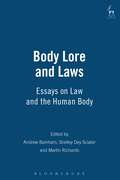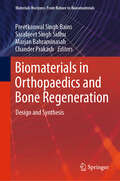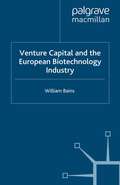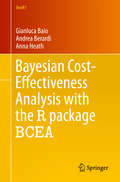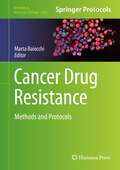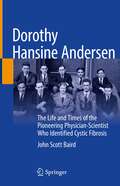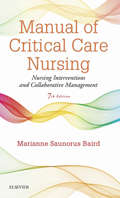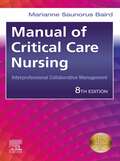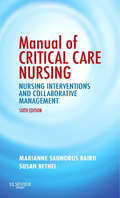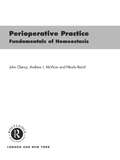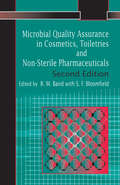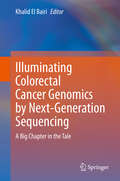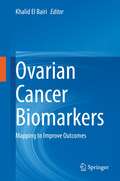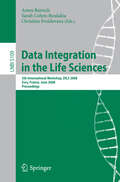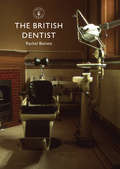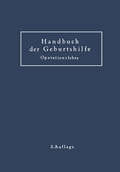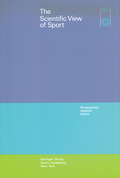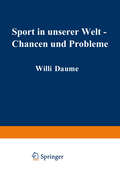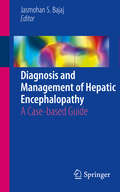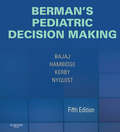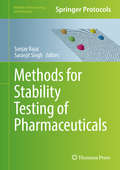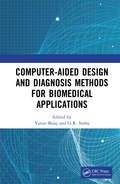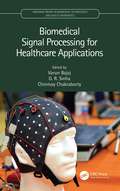- Table View
- List View
Body Lore and Laws: Essays on Law and the Human Body
by Andrew Bainham Shelley Day Sclater Martin RichardsThis book,the second produced by the Cambridge Socio-Legal Group, is a collection of essays on the subject of law and the human body. As the title suggests, bodies and body parts are not only subject to regulation through formal legal processes, but also the meanings attached to particular bodies, and the significance accorded to some body parts, are aspects ofbroader cultural processes. In short, bodies are subjected to both lore and laws. The contributors, all leading academics in the fields of Law, Sociology, Psychology, Feminism, Criminology, Biology and Genetics, respectively, offer a range of interdisciplinary papers that critically examine how bodies are constructed and regulated in law.The book is divided into two parts. Part one is concerned with 'Making Bodies' and includes papers relating to transactions in human gametes, cloning, court-ordered caesarean sections, testing for genetic risk, the patenting of human genes and the social policy implications of the growth in genetic information. Part two is concerned with 'Using and Abusing Bodies'. It contains chapters relating to sexualities, sexual orientation and the law, sex workers and their clients, domestic homicide, religious and cultural practices and other issues involving children's bodies, the ownership of the body and body parts and the legal and ethical issues surrounding euthanasia.
Biomaterials in Orthopaedics and Bone Regeneration: Design and Synthesis (Materials Horizons: From Nature to Nanomaterials)
by Preetkanwal Singh Bains Sarabjeet Singh Sidhu Marjan Bahraminasab Chander PrakashThis book focuses on the recent advances in the field of orthopaedic biomaterials, with a particular emphasis on their design and fabrication. Biomimetic materials, having similar properties and functions to that of the natural tissue, are becoming a popular choice for making customized orthopaedic implants and bone scaffolds. The acceptability of these materials in the human body depends on the right balance between their mechanical and biological properties. This book provides a comprehensive overview of the state-of-the-art research in this rapidly evolving field. The chapters cover different aspects of multi-functional biomaterials design, and cutting-edge methods for the synthesis and processing of these materials. Advanced manufacturing techniques, like additive manufacturing, used for developing new biomimetic materials are highlighted in the book. This book is a valuable reference for students and researchers interested in biomaterials for orthopaedic applications.
Venture Capital and the European Biotechnology Industry
by W. BainsThis book opens up the world on private equity investment in one of the hottest industries – Biotechnology. The book describes how Europe has fallen behind the US due to under-investment and bad management by the VCs who control the companies. Detailed analysis shows why it is in VCs' interests to damage the very companies they invest in.
Bayesian Cost-Effectiveness Analysis with the R package BCEA (Use R!)
by Gianluca Baio Andrea Berardi Anna HeathThe book provides a description of the process of health economic evaluation and modelling for cost-effectiveness analysis, particularly from the perspective of a Bayesian statistical approach. Some relevant theory and introductory concepts are presented using practical examples and two running case studies. The book also describes in detail how to perform health economic evaluations using the R package BCEA (Bayesian Cost-Effectiveness Analysis). BCEA can be used to post-process the results of a Bayesian cost-effectiveness model and perform advanced analyses producing standardised and highly customisable outputs. It presents all the features of the package, including its many functions and their practical application, as well as its user-friendly web interface. The book is a valuable resource for statisticians and practitioners working in the field of health economics wanting to simplify and standardise their workflow, for example in the preparation of dossiers in support of marketing authorisation, or academic and scientific publications.
Cancer Drug Resistance: Methods and Protocols (Methods in Molecular Biology #2535)
by Marta BaiocchiThis volume discusses the latest techniques used to identify cancer drug resistance determinants at the molecular, cellular, and functional levels. Chapters in this book cover up-to-date topics including tumor-microenvironment cell co-culture methods and microfluidics systems; workflows for functional assessment of drug resistance in vitro and in vivo; quantitative techniques for identifying quiescent blood-flow circulating cells; and single-cell characterization methods, such as mass cytometry. Written in the highly successful Methods in Molecular Biology series format, chapters include introductions to their respective topics, lists of the necessary materials and reagents, step-by-step, readily reproducible laboratory protocols, and tips on troubleshooting and avoiding known pitfalls.Cutting-edge and practical, Cancer Drug Resistance: Methods and Protocols is a valuable resource for all scientists and researchers who are looking to learn more about the latest developments in understanding and overcoming anticancer drug resistance.
Dorothy Hansine Andersen: The Life and Times of the Pioneering Physician-Scientist Who Identified Cystic Fibrosis
by John Scott BairdThis book chronicles the life and accomplishments of Dorothy Hansine Andersen, a pioneering American pathologist and pediatrician who was the first person to define, diagnose, and treat cystic fibrosis.Divided into three parts, the book begins by detailing Anderson’s early life, including being orphaned as an adolescent, her college career, and her laborious start in the medical field. Part II then examines Andersen’s role in defining the new disease “cystic fibrosis of the pancreas” and her career of active engagement in various clinical pursuits and research, both in pathology and pediatrics. Chapters in this section also discuss the numerous attempts made by others to minimize Andersen’s work through gender bias and the Matilda Effect. The book concludes by reviewing the foundations laid for CF, Andersen’s legacy, and her terminal illness. Featuring an engaging narrative style, Dorothy Hansine Andersen is a historically relevant, invaluable text for anyone interested in the life of Dorothy Anderson and the nascence of cystic fibrosis diagnoses.
Manual of Critical Care Nursing - E-Book: Nursing Interventions and Collaborative Management
by Marianne Saunorus BairdThe compact, yet comprehensive, Manual of Critical Care Nursing: Nursing Interventions and Collaborative Management, 7th Edition is your students’a go-to reference forto help you provide safe, high-quality nursing care in the clinicalcritical care settings. Written in an abbreviated outline format, this easy-to-use Manual presents essential information on more than 75 disorders and conditions, as well as concepts relevant to caring for all critically ill patients and functioning in the critical care environment. Award-winning clinical nurse specialist Marianne Baird separates the content first by body system and then by disorder, with each disorder including a brief description of pathophysiology, assessment, diagnostic testing, collaborative management, nursing diagnoses, desired outcomes, nursing interventions, and patient teaching and rehabilitation. With the latest NANDA-I nursing diagnoses and new sections on Bariatric Considerations and Caring for the Elderly, this practical manual is designed to help critical care nurses and nursing students better care for any critically ill patient.Coverage of more than 75 disorders most commonly seen in critical care units.Consistent, easy-to-use format facilitates quick reference so you can find information exactly where you expect it to be.Portable size makes it ideal for use in the unit or bedside, and is also easy to carry on campus.Research Briefs boxes present abstracts of selected research studies and emphasize the use of evidence to guide care recommendations. NANDA-approved diagnoses are marked with an icon to familiarize you with NANDA terminology.Chapters mirror a practicing nurse’s approach to patient care, making it quicker and easier to find information. Diagnostic Tests tables highlight the definition, purpose, and abnormal findings for each test.Collaborative Management tables concisely summarize relevant performance measures while incorporating the best available patient care guidelines.Safety Alert! and High Alert! icons call attention to issues important to a patient’s safety.Chapter outlines display major heads, care plans, and their respective page numbers - and provide easy access to disorders.NEW! Bariatric Considerations section added to assessment sections to help you assess, and prevent complications and improve care in, overweight and obese patients. NEW! Section on Caring for the Elderly added to assessment sections to provide you with tips and guidelines unique to elderly patients, including recognizing differences in measuring pain, providing appropriate nutritional support, improving communication, and preventing infection.NEW! Updated content throughout keeps you current in the field of critical care nursing. NEW! Geriatric icon highlights considerations relating to the care of older adults. NEW! The latest NANDA-I nursing diagnoses ensure you stay up-to-date.
Manual of Critical Care Nursing - E-Book: Nursing Interventions and Collaborative Management
by Marianne Saunorus BairdCompact, yet comprehensive, Manual of Critical Care Nursing: Interprofessional Collaborative Management, 8th Edition is the go-to reference for helping you provide safe, high-quality nursing care in critical care settings. Written in an abbreviated outline format, it presents essential information on more than 75 disorders and conditions, as well as concepts relevant to caring for critically ill patients and functioning in the critical care environment. Award-winning clinical nurse specialist Marianne Baird separates the content first by body system and then by disorder, with each disorder including a brief description of pathophysiology, assessment, diagnostic testing, collaborative management, nursing diagnoses, desired outcomes, nursing interventions, and patient teaching and rehabilitation. Coverage of more than 75 disorders most commonly seen in progressive and critical care settings equips you with all the content needed to handle problems in critical care nursing. Consistent, easy-to-use format mirrors a practicing nurse's approach to patient care and facilitates quick reference to vital information. Diagnostic Tests tables highlight the definition, purpose, and abnormal findings for each test. Gerontologic considerations and bariatric considerations are highlighted throughout to direct attention to patients with unique needs in critical care settings. NOC outcomes and NIC interventions apply standardized nursing taxonomies to the disorders and conditions most commonly encountered in progressive and critical care settings. Portable size makes it ideal for use on the unit or at the bedside. Safety Alert! and High Alert! boxes call attention to issues vital to patient safety. NEW! Focused content and a more streamlined, quick-reference format emphasize generic "patient problems" language in lieu of nursing-specific diagnoses to promote interprofessional collaboration and improved communication facilitated by a shared language. UPDATED! Comprehensive coverage reflects the latest evidence-based practice and national and international treatment guidelines. NEW and UNIQUE! Coverage of interprofessional collaborative management includes Interprofessional Collaborative Management headings and tables that concisely summarize relevant performance measures while incorporating the best available patient care guidelines. NEW! Enhanced focus on need-to-know content facilitates quicker information retrieval in time-sensitive high acuity, progressive, and critical care settings.
Manual of Critical Care Nursing - E-Book: Nursing Interventions and Collaborative Management
by Marianne Saunorus Baird Susan BethelIt's the ideal go-to reference for the clinical setting! Compact and easy to use, Manual of Critical Care Nursing, 6th Edition presents essential information on approximately 80 disorders and conditions, as well as concepts relevant to caring for all critically ill patients and functioning in the critical care environment. Award-winning clinical nurse specialists Marianne Baird and Sue Bethel separate the content first by body system and then by disorder, with each disorder including a brief description of pathophysiology, assessment, diagnostic testing, collaborative management, nursing diagnoses, desired outcomes, nursing interventions, and patient teaching and rehabilitation. A concise format presents the material in a way that reflects a practicing nurse's thought processes.Coverage of approximately 80 critical care conditions/disorders includes those most commonly seen in critical care units.Chapter outlines provide easy access to disorders.A portable size makes it ideal for use in the unit or bedside, and is also easy to carry on campus.Unique! Gerontology icon highlights considerations relating to the care of older adults. Unique! Research briefs in special boxes discuss selected research studies for evidence-based patient care.Unique! The latest NANDA-approved nursing diagnoses increase familiarity with NANDA terminology.Appendixes provide quick reference to information needed in the critical care setting.Revised format mirrors a practicing nurse's approach to patient care, making it easier to find information.Newly formatted care plans incorporate diagnoses, interventions, and desired outcomes in a consistent, logical organization.Patient safety alerts and high alerts call attention to issues important to a patient’s safety.Unique! Diagnostic Tests tables highlight the definition, purpose, and abnormal findings for each test.Unique! Collaborative Management tables concisely summarize key points while incorporating nationally recognized guidelines.Colored tabs mark the location of each body system, making topics easier to find.Smaller trim size increases portability for use in the unit or bedside, while enhancing readability.
Perioperative Practice: Fundamentals of Homeostasis
by Nicola Baird John Clancy Andrew McVicarWritten by experienced nurse lecturers and a theatre nurse, Perioperative Practice highlights and explains the biological processes which can be disrupted by a major surgical procedure. Using the concept of homeostasis as a framework, the authors look at issues common to all surgical procedures such as the influence of anaesthesia on the nervous system or perioperative pain management. Individual chapters cover: the human body and principles of homeostasis the surgical approach and endoscopic procedures perioperative influences on body fluid homeostasis perioperative influences on immunological homeostasis and wound healing perioperative influences on cardiovascular homeostasis perioperative influences on respiratory homeostasis anaesthesia, stress and surgery pain and pain relief in the perioperative patient. Generously illustrated in colour and black and white, the text features further learning activities and useful summaries of key points. It provides an important resource and supporting text for all nurses undertaking courses in theatre work or related areas or already working in such areas.
Perioperative Practice: Fundamentals of Homeostasis
by Nicola Baird John Clancy Andrew McVicarWritten by experienced nurse lecturers and a theatre nurse, Perioperative Practice highlights and explains the biological processes which can be disrupted by a major surgical procedure. Using the concept of homeostasis as a framework, the authors look at issues common to all surgical procedures such as the influence of anaesthesia on the nervous system or perioperative pain management. Individual chapters cover: the human body and principles of homeostasis the surgical approach and endoscopic procedures perioperative influences on body fluid homeostasis perioperative influences on immunological homeostasis and wound healing perioperative influences on cardiovascular homeostasis perioperative influences on respiratory homeostasis anaesthesia, stress and surgery pain and pain relief in the perioperative patient. Generously illustrated in colour and black and white, the text features further learning activities and useful summaries of key points. It provides an important resource and supporting text for all nurses undertaking courses in theatre work or related areas or already working in such areas.
Microbial Quality Assurance in Pharmaceuticals, Cosmetics, and Toiletries
by R. Baird Sally F. BloomfieldThe importance of quality assurance in the production, storage and use of manufactured preparations is widely recognized. This book encapsulates the issues involved in the manufacture of non-steriles, such as creams, ointments, herbal remedies, shampoos, soaps and toiletry products (as opposed to sterile drugs and injectible products). Knowledge of the microbial limits is expanded, new standards are included, and coverage of the preservation issues of dosage forms is widened to include semi-solids and liquid preparations. This edition also contains new regulations regarding preservative efficacy testing and covers pharmacopoeial and industry regulations and guidelines. Rapid methods are also discussed, now more common in cosmetic and toiletry practice, in their pharmaceutical capacity.
Microbial Quality Assurance in Pharmaceuticals, Cosmetics, and Toiletries
by R. Baird Sally F. BloomfieldThe importance of quality assurance in the production, storage and use of manufactured preparations is widely recognized. This book encapsulates the issues involved in the manufacture of non-steriles, such as creams, ointments, herbal remedies, shampoos, soaps and toiletry products (as opposed to sterile drugs and injectible products). Knowledge of the microbial limits is expanded, new standards are included, and coverage of the preservation issues of dosage forms is widened to include semi-solids and liquid preparations. This edition also contains new regulations regarding preservative efficacy testing and covers pharmacopoeial and industry regulations and guidelines. Rapid methods are also discussed, now more common in cosmetic and toiletry practice, in their pharmaceutical capacity.
Illuminating Colorectal Cancer Genomics by Next-Generation Sequencing: A Big Chapter in the Tale
by Khalid El BairiThis book reviews the potential of next-generation sequencing (NGS) in research on and management of colorectal cancer (CRC), a leading cause of death worldwide and one of the most biologically and clinically heterogeneous cancers. It critically discusses findings from recent large-scale studies, clinical trials and meta-analyses and offers an introduction to the management of CRC in the era of precision medicine. In CRC, dozens of driver and passenger mutations are associated with the malignant transformation of epithelial cells. Consequently, the book discusses recent advances in our understanding of the genetics of CRC as a biomarker, the advent of NGS technologies in modern genomics, and the impact of NGS technology on the management of CRC. Furthermore, it highlights the potential of NGS in the context of liquid biopsy and single-cell sequencing in CRC, as well as its role in shedding light on the link between gut microbiota, immune-checkpoint blockade and CRC. The book concludes with a chapter on the limitations and cost-effectiveness of NGS in CRC. Given its scope, the book will appeal to all those interested in learning about the potential of NGS in advancing CRC research and patient care.
Ovarian Cancer Biomarkers: Mapping to Improve Outcomes
by Khalid El BairiThis book comprehensively summarizes the biology, etiology, and pathology of ovarian cancer and explores the role of deep molecular and cellular profiling in the advancement of precision medicine. The initial chapter discusses our current understanding of the origin, development, progression and tumorigenesis of ovarian cancer. In turn, the book highlights the development of resistance, disease occurrence, and poor prognosis that are the hallmarks of ovarian cancer. The book then reviews the role of deep molecular and cellular profiling to overcome challenges that are associated with the treatment of ovarian cancer. It explores the use of genome-wide association analysis to identify genetic variants for the evaluation of ovarian carcinoma risk and prognostic prediction. Lastly, it highlights various diagnostic and prognostic ovarian cancer biomarkers for the development of molecular-targeted therapy.
Data Integration in the Life Sciences: 5th International Workshop, DILS 2008, Evry, France, June 25-27, 2008, Proceedings (Lecture Notes in Computer Science #5109)
by Amos Bairoch Sarah Cohen-Boulakia Christine FroidevauxFor several years now, there has been an exponential growth of the amount of life science data (e. g. , sequenced complete genomes, 3D structures, DNA chips, mass spectroscopy data), most of which are generated by high-throughput - periments. This exponentialcorpusof data is storedand made availablethrough a large number of databases and resources over the Web, but unfortunately still with a high degreeof semantic heterogeneity and varying levels of quality. These data must be combined together and processed by bioinformatics tools deployed on powerful and e?cient platforms to permit the uncovering of patterns, s- ilarities and in general to help in the process of discovery. Analyzing complex, voluminous, and heterogeneous data and guiding the analysis of data are thus of paramount importance and necessitate the involvement of data integration techniques. DILS 2008 was the ?fth in a workshop series that aims at fostering disc- sion, exchange, and innovation in research and development in the area of data integration for the life sciences. Each previous DILS workshop attracted around 100 researchers from all over the world and saw an increase of submitted - pers over the preceding one. This year was not an exception and the number of submitted papers increased to 54. The ProgramCommittee selected 18 of them. The selected papers cover a wide spectrum of theoretical and practical issues including data annotation, Semantic Web for the life sciences, and data mining on integrated biological data.
The British Dentist (Shire Library)
by Rachel BairstoThough the prospect may fill us with dread, most of us need dental treatment at some stage – and the reality is that better care has never been available, as this fully illustrated book shows. Early dentistry was amateurish and limited to barber-surgeons, travelling tooth-pullers and blacksmiths, with patients often suffering as much from the cure as the malady; and even as things improved in the eighteenth century, fashionable dentures were still made from the teeth of dead soldiers or even of the poor. This authoritative introduction looks at this whole grisly history as well as at the increasing professionalism seen from the late nineteenth century onwards, which has led to very dramatic improvements in dental treatment, including modern dentures, amalgam fillings, anaesthetics and orthodontics, and to the current boom in cosmetic dentistry.
Geburtshilfliche Operationslehre: Ergänzungsband zum Handbuch der Geburtshilfe
by K. Baisch M. Hofmeier W. Zangemeister A. DöderleinDieser Buchtitel ist Teil des Digitalisierungsprojekts Springer Book Archives mit Publikationen, die seit den Anfängen des Verlags von 1842 erschienen sind. Der Verlag stellt mit diesem Archiv Quellen für die historische wie auch die disziplingeschichtliche Forschung zur Verfügung, die jeweils im historischen Kontext betrachtet werden müssen. Dieser Titel erschien in der Zeit vor 1945 und wird daher in seiner zeittypischen politisch-ideologischen Ausrichtung vom Verlag nicht beworben.
The Scientific View of Sport: Perspectives, Aspects, Issues
by H. Baitsch H. E. Bock M. Bolte W. Bokler O. Grupe H. W. Heidland F. Lotzprogress and happiness - however these terms may be understood in detail - as a significant and constitutive element of scientific inquiry. In this sense the question of the way in which sport really benefits people and contributes to their happiness, and under which individual and social conditions, is a scientific question. It assumes special significance when the fact is taken into account that in the field of sport science a general scepticism is shown towards those dogmas and pedagogical theses which take such an interpretation for granted in the absence of a firm empirical foundation and a critically evolved theory. Sport and Sport Science Sport and exercise, physical culture and education in sport (physical training), gymnastics and touring combined with some form of sport are-as the present report distinctly shows-all over the world among the most striking social phenom ena of today. At first sight they seem to be uncomplicated, clear and comprehensible for everybody; they stand for a type of solidarity which is independent of differences in ideological-political outlook, and sometimes exhibit an almost archaic intensity and attraction; they are supported by the active participation or at least the interest of very many people in many parts of the world and are endued with specific func tions, varying in importance, of a medical (therapeutical, prophylactic, rehabilitative), pedagogical, psychological and social character.
Sport in unserer Welt — Chancen und Probleme: Referate, Ergebnisse, Materialien Wissenschaftlicher Kongreß München vom 21.–25. August 1972
by H. Baitsch H. E. Bock M. Bolte W. Bokler H. W. Heidland F. LotzSoll ein wissenschaftlicher Kongreß in Verbindung mit den Olympischen Spielen stattfinden und Wissenschaft nicht nur als angewandte Wissenschaft in der Betreuung von Athleten vertreten sein, sondern auch als informierende, reflektierende und kritische Instanz? Das Organisationskomitee für die Spiele der XX. Olympiade hat sich dafür entschieden, und das Ergebnis hat ihm recht gegeben. Der Einladung des Organisationskomitees sind viele hervorragende Wissen schaftler und viele Teilnehmer aus der ganzen Welt nachgekommen; sie machten es möglich, das Thema des Kongresses in vielfältiger Weise unter verschiedensten Aspekten und unvoreingenommen-fair zu erörtern. Dafür ist allen zu danken. Nun liegt der Kongreßbericht vor. Er ist ein Teil des wissenschaftlichen Gesamt konzepts, zu dem das vorbereitende Werk, "Sport im Blickpunkt der Wissenschaften, Perspektiven, Aspekte, Ergebnisse", der Kongreß selbst und dieser Kongreßbericht gehören, und in engem Zusammenhang damit die Ausstellungen "100 Jahre deutsche Ausgrabung in Olympia", "Sport und Medizin" und die Literaturausstellung. Es ist zu hoffen, daß dieser Bericht für die Teilnehmer und die Wissenschaftler, Studenten, Lehrer und Trainer, die nicht teilnehmen konnten, eine wichtige Quelle von Informationen und Diskussionen wird und damit die fruchtbare Weiterent wicklung des Münchener Kongresses sichert. Denjenigen, die sich der Mühe unter zogen haben, dieses Dokument zu erstellen, ist zu danken. Im Rahmen dessen, was von den Olympischen Spielen 1972 bleibt, wird es ein wichtiges Teilstück sein.
Diagnosis and Management of Hepatic Encephalopathy: A Case-based Guide
by Jasmohan S. BajajThis volume provides a comprehensive, state-of-the-art overview of hepatic encephalopathy. Through a case-based approach, the text reviews new data and studies about the role of microbiota in liver disease and hepatic encephalopathy, explores the burden of hepatic encephalopathy on readmissions, costs, and patient care, and highlights management strategies for patients in differing stages of hepatic encephalopathy. Exploratory new therapies and treatment targets are also discussed in the guide.Written by experts in the field, Diagnosis and Management of Hepatic Encephalopathy: A Case-based Guide is a valuable resource for physicians and researchers who deal with this challenging complication of cirrhosis.
Berman's Pediatric Decision Making E-Book
by Lalit Bajaj Simon Hambidge Ann-Christine Nyquist Gwendolyn KerbyBerman’s Pediatric Decision Making uses an algorithmic, structured approach to lead you to the right diagnosis and treatment every time. Drs. Lalit Baja, Simon Hambidge, Ann-Christine Nyquist, and Gwendolyn Kerby use evidence-based research and flow charts for each presenting complaint or specific disorder to provide quick access to the information you need for effective decision making. With updated drug tables and revised algorithms, this streamlined new edition makes it even easier for you to diagnose and manage common clinical problems from infancy through adolescence. Rapidly access guidance on diagnosis and management from algorithms for each clinical disorder. Treat the full range of diseases and disorders with comprehensive coverage of diagnosis, assessment of severity, and clinical management. Choose the best treatment for each case thanks to indications for surgical interventions as well as expensive diagnostic proceduresStay current on recent developments and make effective decisions for movement disorders, physical abuse in children, sexual abuse in children, eating disorders, ADHD, and other hot topics. Find answers quickly and easily with a new table of contents organized into two sections—Presenting Complaints and Specific Disorders—that reduces the need to flip between chapters. Tap into the diverse perspectives of expert authors from all over the country. Get only the information you need in the streamlined new edition with shorter, more user-friendly flow diagrams and fewer specialized chapters.
Methods for Stability Testing of Pharmaceuticals (Methods in Pharmacology and Toxicology)
by Sanjay Bajaj Saranjit SinghThis detailed volume collects numerous methods and protocols related to different aspects of stability programs that are followed in pharmaceutical development laboratories. Implementation of a successful stability program, vital in preventing product failures and recalls, requires critical and logical thinking that goes beyond the regular documented protocols and methods, so the experiences of the book’s internationally-based expert contributors fill the chapters with practical guidance. As a volume in the Methods in Pharmacology and Toxicology series, this book presents the kind of real-world advice that is essential for advancing laboratory research. Authoritative and thorough, Methods for Stability Testing of Pharmaceuticals serves as a valuable addition to the existing armamentarium of resources available to stability testing personnel in research and industry.
Computer-aided Design and Diagnosis Methods for Biomedical Applications
by Varun Bajaj G. R. SinhaComputer-aided design (CAD) plays a key role in improving biomedical systems for various applications. It also helps in the detection, identification, predication, analysis, and classification of diseases, in the management of chronic conditions, and in the delivery of health services. This book discusses the uses of CAD to solve real-world problems and challenges in biomedical systems with the help of appropriate case studies and research simulation results. Aiming to overcome the gap between CAD and biomedical science, it describes behaviors, concepts, fundamentals, principles, case studies, and future directions for research, including the automatic identification of related disorders using CAD. Features: Proposes CAD for the study of biomedical signals to understand physiology and to improve healthcare systems’ ability to diagnose and identify health disorders. Presents concepts of CAD for biomedical modalities in different disorders. Discusses design and simulation examples, issues, and challenges. Illustrates bio-potential signals and their appropriate use in studying different disorders. Includes case studies, practical examples, and research directions. Computer-Aided Design and Diagnosis Methods for Biometrical Applications is aimed at researchers, graduate students in biomedical engineering, image processing, biomedical technology, medical imaging, and health informatics.
Biomedical Signal Processing for Healthcare Applications (Emerging Trends in Biomedical Technologies and Health informatics)
by Varun Bajaj G. R. Sinha Chinmay ChakrabortyThis book examines the use of biomedical signal processing—EEG, EMG, and ECG—in analyzing and diagnosing various medical conditions, particularly diseases related to the heart and brain. In combination with machine learning tools and other optimization methods, the analysis of biomedical signals greatly benefits the healthcare sector by improving patient outcomes through early, reliable detection. The discussion of these modalities promotes better understanding, analysis, and application of biomedical signal processing for specific diseases. The major highlights of Biomedical Signal Processing for Healthcare Applications include biomedical signals, acquisition of signals, pre-processing and analysis, post-processing and classification of the signals, and application of analysis and classification for the diagnosis of brain- and heart-related diseases. Emphasis is given to brain and heart signals because incomplete interpretations are made by physicians of these aspects in several situations, and these partial interpretations lead to major complications. FEATURES Examines modeling and acquisition of biomedical signals of different disorders Discusses CAD-based analysis of diagnosis useful for healthcare Includes all important modalities of biomedical signals, such as EEG, EMG, MEG, ECG, and PCG Includes case studies and research directions, including novel approaches used in advanced healthcare systems This book can be used by a wide range of users, including students, research scholars, faculty, and practitioners in the field of biomedical engineering and medical image analysis and diagnosis.
